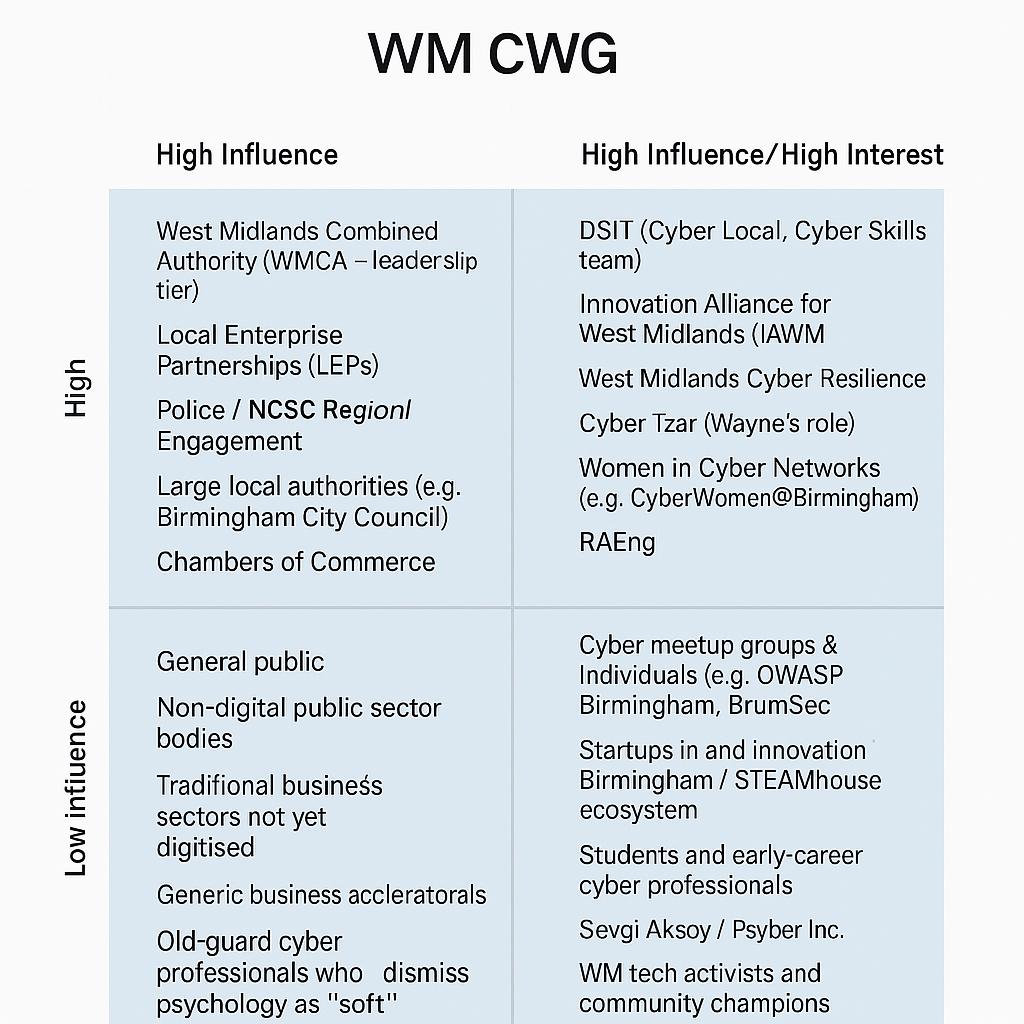The West Midlands Cyber Working Group (WM CWG) plays a pivotal role in uniting industry, academia, government, and grassroots cyber communities across the region. This article outlines how WM CWG applies stakeholder mapping to guide its coordination efforts, balancing the interests of funders, civic authorities, partners, and community actors.
The result is a practical tool for building inclusive, high-impact collaboration within a growing innovation ecosystem.
This article is with thanks to Robin Kennedy and Emma Fadlon of Innovate UK, based on my time with the academic leaders on the 2025 CyberASAP cohort. Thank you!
1. Manage Closely (High Influence / High Interest)
Strategic relationships and key decision-makers
- DSIT (Cyber Local, Cyber Skills team) – funding and direction-setting
- Innovation Alliance for the West Midlands (IAWM) – strategic convenor
- Midlands Cyber – regional partner and national connector
- West Midlands Cyber Resilience Centre (WM CRC) – operational delivery partner
- Universities with cyber strengths – e.g., Aston, Birmingham, Wolverhampton, Coventry
- Pam Waddell OBE / Cliff Dennett / IAWM leadership – regional innovation champions
- Ryan Protheroe (Midlands Cyber) – key CWG collaborator
- Andy Smith / UK Telecoms Lab (UKTL) – anchor for telecom and cyber innovation in Telford
- WMCA Digital & Innovation teams – influence over regional strategy and funding
2. Keep Satisfied (High Influence / Low Interest)
Powerful stakeholders not yet fully engaged
- West Midlands Combined Authority (WMCA – executive leadership)
- Local Enterprise Partnerships (LEPs) – currently being restructured, but still relevant
- Police / NCSC (regional engagement) – major players, not yet deeply involved locally
- Large local authorities – e.g., Birmingham City Council, influential in procurement
- Chambers of Commerce – regional business voice, cyber increasing as a priority
- Large corporates headquartered in WM – e.g., Jaguar Land Rover, Cadbury – potential partners
- Catapults (e.g., MTC, Digital Catapult) – high-tech enablers, require alignment and funding
3. Keep Informed (Low Influence / High Interest)
Supporters, early adopters, and community champions
- Cyber meetup groups and individuals – e.g., OWASP Birmingham, BrumSec
- Smaller cyber companies and consultants – eager for visibility and connections
- Startups in the Innovation Birmingham and STEAMhouse ecosystems
- Students and early-career cyber professionals – the region’s future talent pipeline
- Slack group participants and newsletter subscribers – already engaged in CWG dialogue
- Sevgi Aksoy / Psyber Inc. – emerging niche contributor focused on human factors
- Tech activists and local ecosystem champions – e.g., SuperTech, TechWM
- CyberWomen@Birmingham – highly engaged, building traction
4. Monitor (Low Influence / Low Interest)
Minimal engagement unless activated
- General public – unless reached via public campaigns or news
- Non-digital public sector bodies – e.g., NHS Trusts without a cyber remit
- Traditional business sectors not yet digitised – e.g., small logistics, light manufacturing
- Local charities – unless exposed to digital risk
- Dormant clusters or inactive competitors – potential to re-engage in future
Summary
Stakeholder mapping provides WM CWG with a structured approach to engagement, highlighting existing collaborators, gaps in influence, and opportunities to activate regional support. As the group prepares for upcoming projects like the Cyber Local bid and the West Midlands Cyber Festival, this tool will remain critical in shaping who’s invited to the table, and why.
